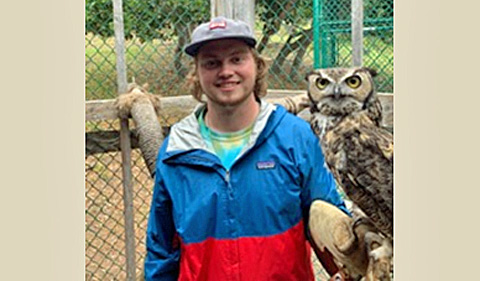Editor’s Note: The Happy Beginnings series features recent College of Arts & Sciences graduates who are getting started in careers, graduate school and service.
By Adam Hunt ’18
B.S. in Marine Freshwater Environmental Biology
Working in the fish lab has been an incredible experience for my career. Honestly, I wish could travel back in time to tell myself to start it earlier.
Unfortunately, it’s hard for students (myself especially) to see the importance of working in the lab until those final years of undergrad arrive. Nevertheless, I felt extremely welcomed and challenged to think and explore new ideas with other intelligent minds.
As undergraduates, we sit in lectures where we are constantly listening to people tell us what is what. I think it is incredibly self-fulfilling and rejuvenating to be able to finally express the way you see the world and work with groups of people who are ready to listen to your ideas.
For many of us in the field of biology, graduate school is generally the next step, and working in the lab was the perfect preview of that. Lastly, working in the lab put me in a position to make endless connections and achieve publication credits.
I am currently working in California as a naturalist, mainly teaching outdoor education. Aside from the many lessons, my work here deals with handling and taking care of raptors, reptiles, amphibians and marine organisms found within the inter-tidal zone.
Editor’s Note: Hunt is a coauthor on Selection on growth rates via a trade-off between survival to sexual maturity and longevity in the swordtail fish Xiphophorus multilineatus, which stems from his work in the fish lab with Dr. Molly Morris, Professor of Biological Sciences.
Abstract: There is growing evidence across taxa for a mortality-growth rate tradeoff, however the extent to which individuals experience selection both for and against growing faster in the wild can be difficult to assess. We used otoliths to assess growth rates in the wild for Xiphophorus multilineatus, a species of swordtail fish with genetically influenced male alternative reproductive tactics. The ARTs are thought to be maintained due to a trade-off between a higher probability of reaching sexual maturity (smaller sneaker males) and maturing later as a large male with higher mating success (larger courter males). We show that the early juvenile growth rates of the subadult courter males were faster as compared to the other juveniles, potentially suggesting selection for growing faster to increase the probability of reaching sexual maturity. However, variance in the early juvenile growth rates of adult courter males was reduced (truncating high values) as compared to the subadult courter males and overall growth rates were faster in the subadult courter males than the adult courter males. These results support a cost of growing faster as juveniles: reduced longevity as an adult. We also detected a negative relationship between the early growth rates of females and their age, further supporting a longevity cost to growing faster. While both male ARTs are likely to experience stabilizing selection on growth rates, the differences between the morphs in how they optimize this tradeoff in relation to overall fitness (courters optimize growing faster to increase probability of reaching sexual maturity, sneakers optimize longevity as adults) has the potential to lead to disruptive selection between the ARTs on growth rates. We show that the data collected here is consistent with the “growth-mortality optimization” hypothesis and highlight some of the challenges that stabilizing selection presents for examining adaptive variation of growth rates in a natural environment.
Citation: Weinstein W, Liotta MN, Solitt A, Hunt A, Abbott JK, Rios-Cardenas O, Morris MR (2019) Selection on growth rates via a trade-off between survival to sexual maturity and longevity in the swordtail fish Xiphophorus multilineatus. Evolutionary Ecology, 1-18




















Comments